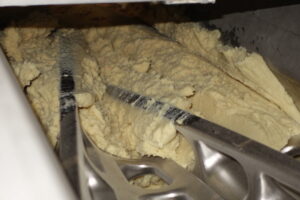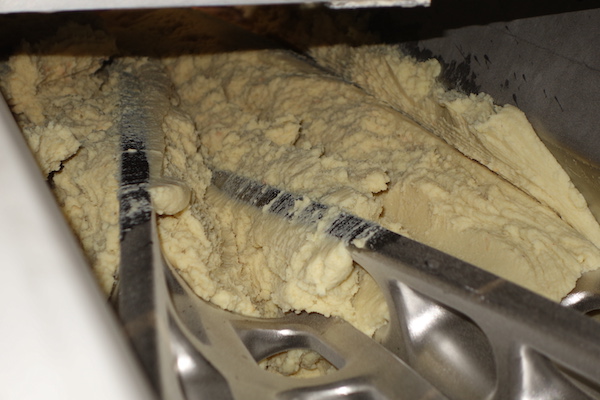 Continuous mixing equipment has been available for quite a while, but only recently has the idea of continuous processing started to take hold in the bakery industry. Batch mixing is the standard, and processors haven’t seen the need to change their production models.
Continuous mixing equipment has been available for quite a while, but only recently has the idea of continuous processing started to take hold in the bakery industry. Batch mixing is the standard, and processors haven’t seen the need to change their production models.
But, a couple of developments have made bakery manufacturers rethink their operations with an eye toward continuous mixing:
- The need for higher quality and more reliable consistency — Building trust with consumers requires quality and consistency. If you make products that are sometimes too soft and sometimes too crispy, your customers will switch to a brand that provides the same experience every time.
- The need for higher throughput — Especially since the beginning of the pandemic, food manufacturers have struggled to keep up with demand. This has prompted many companies to build new lines or retool their existing ones for greater production.
- Labor shortages — The manufacturing workforce has been steadily shrinking, prompting companies to adopt more automated processes.
Continuous mixing helps bakery manufacturers solve all of these challenges and provides other benefits as well. Let’s take a look.
Top benefits of continuous mixing
1. Consistency at every step of the process
Hands-down, the biggest benefit of continuous mixing on a bakery line is consistency. With batch mixing, there are many opportunities for inconsistencies to sneak in. For example, an operator may not accurately load the ingredients or the dough may not be evenly hydrated.
One of the main causes of inconsistency is what our partners at Sobatech call “the challenge of the head and tail of a batch system.” Here’s what that means:
Suppose you make cookies in a batch process. You put all of the ingredients into the mixer for 10 minutes and then empty the dough into a receiving hopper of the dough makeup line, where it stays for 12 minutes. You mix another batch in the mixer for 10 minutes and then transfer it to the receiving hopper, where it also waits for 12 minutes.
At this point, you have two doughs at different stages of development in the hopper — the older dough (22 minutes old) and the younger dough (12 minutes old).
As you know, 10 minutes can make a lot of difference in dough characteristics such as density and temperature. These differences introduced at the mixing stage can lead to inaccurate weighing, inconsistent baking, and variable product quality.
For a more complete discussion of the “head and tail” problem, watch this video from Sobatech:
Continuous mixing provides consistency at the beginning of the line, which enables consistency throughout the rest of the process. By providing a continuous stream of dough, continuous mixing helps you ensure that every portion of dough is treated exactly the same, from fermenting to weighing and portioning to baking.
As an added benefit, this reduces waste because there are fewer products that you have to discard for not meeting specifications. There’s even some evidence that providing dough with consistent parameters can increase the useful life of your oven!
2. Higher throughput in a smaller footprint
Batch systems are limited in their production capabilities. Even a machine that can process 5,000 lbs of dough per batch can’t handle more than a set number of batches per hour, and time is lost between the end of one batch and the beginning of another. To increase production, you’d have to install another mixer.
With continuous processing systems, there’s no wait time. As long as ingredients keep being loaded (a process that’s done automatically), the mixer will keep mixing. Our continuous mixers are capable of processing up to 20,000 lbs of dough every hour.
3. Accurate loading of ingredients without the risk of contamination
In a batch system, even if some ingredients, like flour, are measured and loaded via a bulk delivery system, other ingredients, like leaveners, are usually loaded by an operator.
Every touchpoint a person has with your product is the opportunity for a mistake as well as the introduction of a contaminant. In a continuous mixing system, all ingredients are loaded by machine, which increases accuracy and supports food safety.
4. Lower labor requirements
If your company is like most, you’ve likely experienced the impact of the current labor shortage. People are quitting their jobs in droves. In a trend that’s been dubbed “The Great Resignation,” even workers who hung on during the pandemic are leaving for brighter pastures.
As a fully automated process, continuous mixing reduces your labor requirements because you don’t need operators to load ingredients or transfer the dough from the mixer to the rest of the line.
To learn more about automation, download our ebook: Automating Industrial Bakery Production Lines: Benefits and Tips.
5. Lower total cost of ownership
You might think that all of these benefits come at a high price tag, but in fact continuous mixing saves you money in the long run. The upfront cost of continuous equipment is usually higher, but once you factor in the greater throughput, lower labor costs, and less waste, the total cost of ownership is lower than for batch systems.
Would you like to learn more about continuous mixing? Explore our solutions. If you have any questions or would like more information, give us a call at 708-388-7766 or fill out our contact form and we’ll get back to you as soon as possible.

